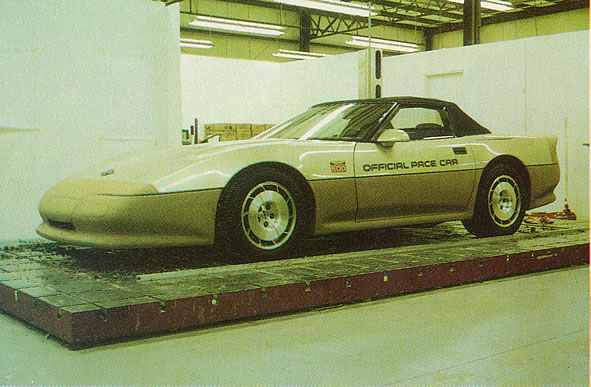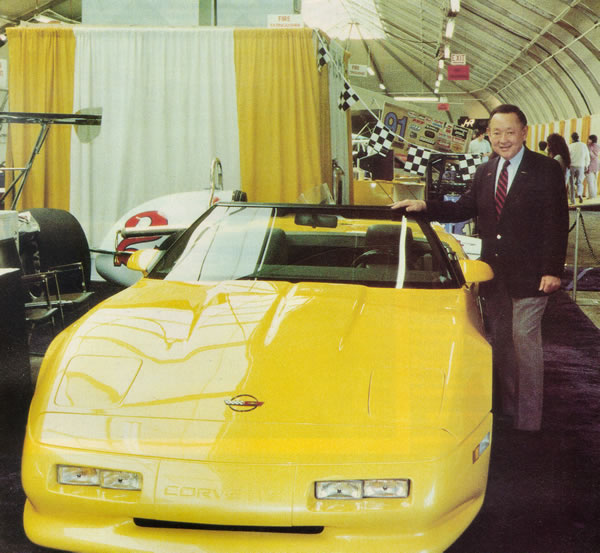1990 Rick Mears Special Edition Corvette
 |
 |
 |
Rick Mears Corvette: Interview with Larry Shinoda
© Wayne Ellwood, 1995
Used here with permission by the author
Q. How did the Rick Mears car start?
A. The idea goes back to about late 1986, about the time the Corvette was the Pace Car at INDY.
Jumping ahead in time just a bit, the project was ultimately funded by Jim Williams, who was one of the sponsors on Penske's cars. His business was called Golden State Foods and he basically provides about 80% of all MacDonalds hamburger meat and packaged condiments. He has a couple of other businesses with other partners doing things like providing the croutons, as well. All together his companies probably gross about $2.2 billion a year. So he's a heavy hitter.
I had met Jim Williams at INDY and got to know him fairly well. Anyway, one year we were talking about various things when I mentioned this Corvette body kit project I had in progress. I told him that I had been consulting with Modern Engineering, which is one of the largest engineering firms in Detroit, trying to help them break into the group of companies that General Motors uses for its projects. I had suggested that we do a Corvette body kit and then they would have a product they could show. I had done some drawings for them but still nothing really happened. They just couldn't seem to get inside.
Finally, I took the drawings in and made an appointment with Chuck Jordan. I used Chuck as my entry point and we got a few people together. I recall that we had Stan Wilen who was the group executive for CPC and John Cafaro who was the chief designer for the Corvette. But he forgot to invite Jerry Palmer. That turned out to be a bit of a faux pas because he felt left out. So the concept really died inside GM after that.
Jim Williams asked when I could show him the drawings of this Corvette. I told him I would show them to him at Long Beach -- that was going to be in April of 1989. Rick Mears happened to be in the motorhome at Long Beach when I did bring the drawings and said he would like to have one of those. So Jim asked him if he would lend his name to it. Rick said he would if it looked like the drawings. At that point we had a deal.
The first Rick Mears "special" was shown at the LA autoshow in January of 1990. We got really good press from that.
When we returned, GM did a wind tunnel test and found out that the design had some features whihc were considerably better than the production Corvette. This shouldn't have been too much of a surprise because the production car was designed to a broader set of criteria and couldn't present all the ideas that I did. A lot of the design work was intuition, as far as the aerodynamics was concerned but I had also talked with some of the GM "aero" people at various points in the process. All I did was soften the original design, enhance it and give it a little bit of the coke bottle. I personally didn't like the belt-line on the production Corvette either, so I took out the rub strip that GM used to hide the body seams.
I think that one of the best features was the "stinger" style rear-end treatment. The wind tunnel test showed that there was really next to no effect from the front end treatment but by pulling out the rocker panels and working on the dam we really achieved some good results. The rocker panels help the wind re-attach to the car along the side of the car. In the production model it just "boils" off the side. Also, we got the same engine cooling with no side gills. The five inches of rear spoiler help the air re-attach to the deck and run off clean. It also generated downforce; it really did a good job on cutting the lift.
The body kit I designed also had a number of features that I like better than the stock Corvette. The rub strips on the proeduction car don't really succeed as a design, in my opinion. I understand that they make the production easier but I just don't like them. My design is much cleaner. From what I have seen, they are retaining the strips on the new C-5 model.
Here is a photo of the Corvette kit with Bill Nichols 1963 in the background. This photo was taken by Ken Hanna of Troy Michigan. He does a lot of work for Corvette Quarterly.
When we talk about aerodynamics, though, I should mention that some of my best work was on the Penske trucks. I really liked that work. The skirts on those trucks really took off the bow wave and helped air flow smoothly down the side. This ended up cutting down the amount of water spray generated as well.

